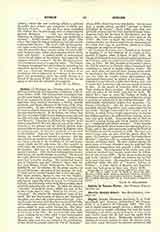

Gugler, JOSEPH HEINRICH ALOYSIUS, b. at Udligerschwyl, near Lucerne, Switzerland, August 25, 1782; d. at Lucerne, February 28, 1827. The only son of simple country people, he was a delicate child and received no regular schooling, but read the books belonging to his father again and again, so that, when only twelve years old, he had read the entire Holy Scriptures several times. Religiously inclined from childhood, he early desired to enter the clerical state, and after many entreaties his parents permitted him to begin his studies at the abbey school of Einsiedeln. When the storms of the French Revolution crossed the Rhine, Abbot Beatus, the religious, and students, in May, 1798, went to the Abbey of St. Gerold, and at the end of the year Gugler was sent to Petershausen, near Constance. In 1800 he continued his classical course at Solothurn. In 1301 he began philosophy, which he finished with great credit at Lucerne according to Kant and Jacobi. Even as a student he showed those opposite traits of character, for which he was noted all through life: a courage ready to overcome any obstacles and fearing no consequences in the defense of right, with at the same time an unobtrusive, almost shrinking nature; a very comprehensive knowledge of men and affairs together with a dread of showing it. During this period he became acquainted with Widmer, a fellow-student, the acquaintance ripening into a life-long friendship. Through the influence of Widmer, Gugler, who had become undecided as to his future career, took up the study of theology, which both pursued at Landshut under Sailer and Zimmer. Shortly before his ordination to the priesthood he was appointed professor of exegesis at the lyceum in Lucerne. After he had received Holy orders, March 9, 1805, at the hands of Testa Ferrata, the papal legate, he was made a canon of the collegiate church of St. Leodegar (Saint-Leger), retaining his position as professor of exegesis. Later he also taught pastoral theology, and 1822-24 acted as prefect of the lyceum.
Gugler and Widmer, who had also been made a professor at Lucerne, put new life into the study of the Scriptures, theology, and cognate branches. Students were encouraged to drop antiquated notions, to think and investigate for themselves, to gain solid knowledge, and to avoid superficiality. The methods of the new teachers brought them into conflict, as well with the supporters of the old school, as with the followers of Wessenberg and the “Illuminati” of Switzerland who accused the professors of unchristian mysticism. A controversy followed between Gugler and Thaddaeus Muller, city pastor of Lucerne, during which appeared, among other writings, Gugler’s “Geist des Christentums and der Literatur im Verhaltniss zu den Thaddaeus Miillerschen Schriften”. Muller made a formal demand to the municipal authorities for the removal of Gugler from the professorship, which was decreed December 12, 1810. Immediately Widmer handed in his resignation, a large number of students threatened to leave, and even the majority of citizens sided with Gugler. Muller saw his mistake, and, at his special request Gugler was reinstated January 23, 1811. Gugler had also a dispute with Marcus Lutz, pastor at Leufelfingen, and issued the sarcastic pamphlet “Chemische Analyse and Synthese des Marcus Lutz zu Leufelfingen” (1816). Another controversy was with Troxler, who later became known as a philosopher. Gugler devoted his time chiefly to teaching and to literary work, but he frequently preached, and he wrote a poem for the twenty-fifth anniversary of Sailer’s ordination. To his scholars he was a true friend, adviser, and consoler. Perhaps the last literary work of Gugler was a protest against the admission of non-Catholics to the Canton of Lucerne, as he wished to preserve for the people the inestimable boon of unity in faith. His career, though short, was a source of great blessing to his country. Sketches of his life were written by Widmer and Geiger, and his biography was prepared by Joseph L. Schiffmann, “Lebensgeschichte des Chorherrn and Professors Aloys Gugler” (Augsburg, 1833); a lengthy article on Gugler and his exegetical works appeared in the “Katholik” (1829), XXXIV, 53, 196.
His principal work is: “Die hl. Kunst oder die Kunst der Hebraer” (1814, 1817, 1818), 3 vols. It is a philosophical exposition of Old Testament Revelation undertaken by a mind which gives full credence to the truth of Revelation, and under the veil of the letter sees hidden treasures of wonderful wisdom which it considers the highest achievement of human investigation to find and give to the world. In 1819 Widmer published the continuation of this work in relation to the New Testament: “Ziffern der Sphinx oder Typen der Zeit and ihr Deuten auf die Zukunft” (Solothurn, 1819). This wishes to show the divine order of current events which are presented in grand pictures and prophetic visions. A periodical founded by Gugler in 1823, “Zeichen der Zeit im Guten and Bosen”, was continued by Dr. Segesser. Among Gugler’s published works is a volume entitled “Privatvortrage”, lectures on the Gospel of St. John, the Epistle to the Hebrews, and the Christian doctrine of St. Augustine, together with a brief sketch of the sacred books of the Old Testament (Sarmenstorf, 1842). His posthumous works were edited by Widmer between 1828 and 1842. A complete list of all his printed works is given in the “Thesaurus librorum rei catholicae” (Würzburg, 1856), I, 337.
FRANCIS MERSHMAN

